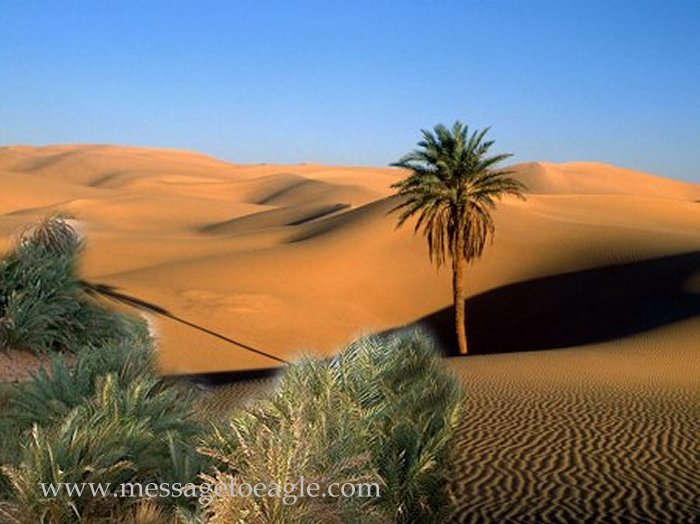Secrets Of The Lost Ancient Sahara Civilization
– The Sahara is the largest desert in the world. At 3-1/2 million square miles, Sahara is as large as the United States and covers one third of the African continent.
With temperatures reaching 135 degrees and humidity as low as 2%, it can be difficult to imagine that this place was once a green paradise.
However, the Sahara, which is one of the hottest and driest places on Earth was as recently as 10,000 years ago a wonderful place to live.
The Green Sahara was a lush savannah teeming with wildlife, grass, trees, and lakes filled with fish.
The region was inhabited by the lost ancient civilization of Sahara.
For about five millennia people thrived here, fishing, hunting, herding cattle, harvesting grain, making pottery and jewellery. Then everything ended…
About 8,000 to 10,000 years ago a major climate shift took place. It was caused by a variation in the angle of the tilt of the Earth and the shape of its orbit. MessageToEagle.com has previously discussed this change in our article What Changed The Green Sahara Into A Desert?
According to climate scientist Gavin Schmidt of NASA’s Goddard Institute for Space Studies, around 8,000 years ago, the Earth’s orbit was slightly different to how it is today.
The tilt changed from around 24.1 degrees to the present-day 23.5 degrees. Changes in the Earth’s tilt cause changes in weather patterns. Such a change is believed to have made the “Green Sahara” go dry.
Rains came to virtual stop. People were forced to leave their paradise and migrate east to the Nile Valley. The new settlements there gave rise to the Egyptian civilization and the dynasties of the pharaohs.

Hidden beneath the sand of Sahara are traces of the civilization that once occupied this land. Archaeologists have recently begun to uncover clues to this lost marvelous world.
At over a hundred of sites, scientists unearthed geological samples, animal bones, tools and fascinating rock art which gave a dramatic and colorful picture of how life looked in the Green Sahara.
If we travel to the heights of the Tassili N’Ajjer in south-eastern Libya, the Hoggar and the Air, it is still possible to see trees like cypress and olive.
They have managed to survive although they are unable to reproduce. Many of them are at least 4,000 years old. Roots extending 25 feet into the ground have kept them supplied with water.
Before the Sahara changed into a desert there were also trees such as ash, cedar, oak, walnut, myrtle and lime in the region.
Camels are today associated with the Sahara, but the animal was unknown to the ancient civilization that lived here 10,000 years ago. Camels did not appear in this region until around the time of Christ.
Various dinosaur fossils have been unearthed in this area. Giant beasts such as Ouranosaurus, Afrovenator, Jobaria, and several other different species that occupied this region in ancient times.
Other animals that lived here were the reptiles and rodents. Both species are easily adaptable to the intense heat of the desert. By hiding two feet below the surface they can find a tolerable temperature environment.
In addition, reptiles are able to live without drinking as their digestive system break down dry plants to manufacture water.
One animal that was frequently seen here was the jerboa, known as the desert rat. In addition to energetic burrowing, the jerboa could also hop on its hind legs, sort of kangaroo-style, moving quickly over the surface.
The hare was also often encountered in the region. Being a good hopper it could move fast and avoid burned feet. Based on the large amount of bones discovered, it is evident that crocodiles controlled the many rivers that are now long gone.
It is possible to learn much about the lost civilization from the incredible Sahara rock art that depicts thousands of years of forgotten history.
Prehistoric rock art in Sahara is in many ways more detailed than the known cave paintings in France and Spain.
The world’s largest collection of fascinating cave paintings was discovered for the first time by modern man in 1842.
Heinrich Barth, a German explorer spent five years in the region examining thousands of prehistoric paintings.
These ancient depictions were found in an area covering all the way from Timbuktu in the west to Chad in the east.
In large caves inside the Tassilli N’Ajjer, in south-eastern Libya, Barth discovered thousands of paintings and engravings. Many of them were huge, some were even feet tall.
The paintings clearly depict how people of the area enjoyed this pre-desert paradise. We can view scenes from ancient daily life. Men are usually portrayed in hunting scenes. Women are seen combing their hair or dancing in circles.
There are many depictions of animals common in the region at this time. Among them we find elephants, rhinoceri, lions, ostriches, giraffes, hippopotami, buffalo, and antelope.
The depictions of homes reveal that people lived in hemispherical grass huts. Various pottery objects are also depicted on several paintings.
People cultivated cattle. There are many depictions of calves, goats, sheep, and pigs. Domestic dogs appear as well. Fishing was also very common activity.
There are many ancient secrets buried beneath the sand of Sahara. Scientists suspect there are large amounts of water under the sand. There are most likely also ancient remains of cities hidden beneath the sand.



 Creators of mankind
Creators of mankind Description of “Tall white aliens”
Description of “Tall white aliens” Where they came from?
Where they came from? About hostile civilizations
About hostile civilizations The war for the Earth
The war for the Earth “Tall white aliens” about eternal life
“Tall white aliens” about eternal life Video: “Nordic aliens”
Video: “Nordic aliens” Aliens
Aliens Alien encounters
Alien encounters The aliens base
The aliens base UFO
UFO Technology UFO
Technology UFO Underground civilization
Underground civilization Ancient alien artifacts
Ancient alien artifacts Military and UFO
Military and UFO Mysteries and hypotheses
Mysteries and hypotheses Scientific facts
Scientific facts


















